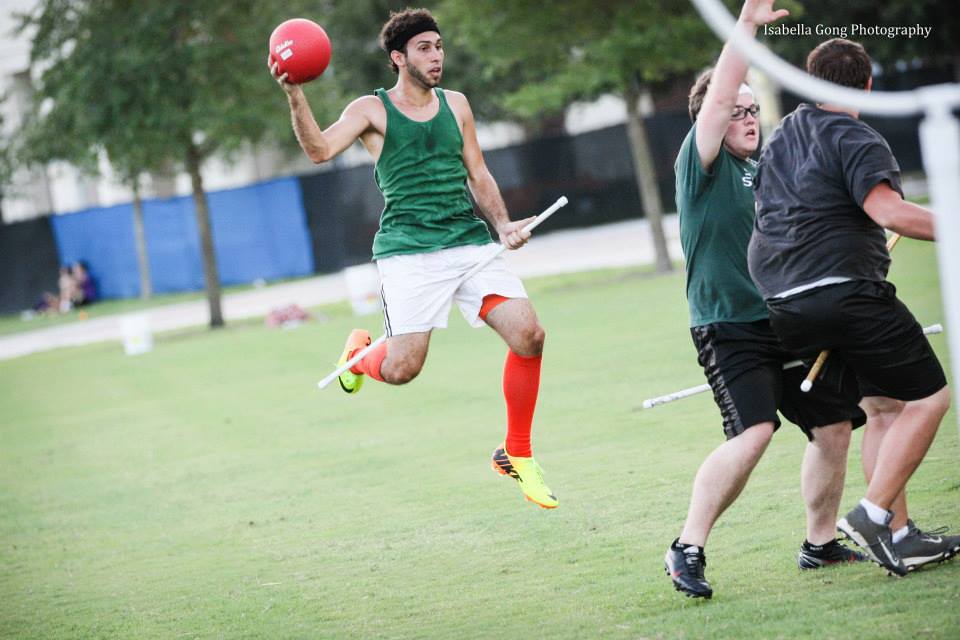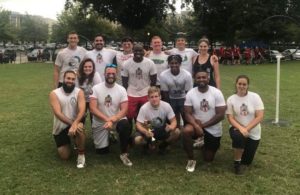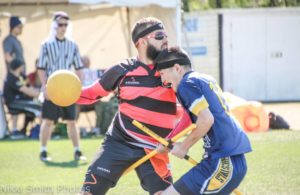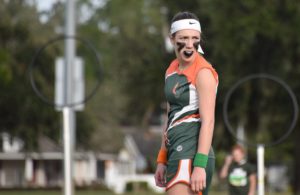- Rule, Britannia, no more?
- Unpopular Opinions: US Quadball Cup 2023
- Proven Contenders: University of Virginia
- Proven Contenders: Rutgers University
- Proven Contenders: University of Michigan
- Proven Contenders: Creighton University
- Different Perspectives: A Look Inside USA Ultimate
- Antwerp QC, Much of Belgian Core, Leaves Competitive Quidditch
Season Previews: South Region
- Updated: September 26, 2013

After a terrible showing at World Cup VI, in which no team made it past the Round of 32, the South is in dire need of catching up with the rest of the quidditch world. Regional champion University of Miami was ousted in an incredibly controversial match with tournament Cinderella Bowling Green State University, while runner-up Tennessee Technological University also lost to BGSU in a play-in game.
Since organized quidditch emerged in the South, there always seems to be one team that conveyed fear into the hearts of every team unlucky enough to play them. Last season, that team was the University of Miami. This year, however, the competition is not so clear cut. The rosters of Miami, University of South Florida and others have been gutted by the region’s new community team, Florida’s Finest. Regional runner-up TTU lost their leading scorer and best beater to graduation. Florida’s Finest has a star-filled roster, but will they be able to turn that into wins? The South is buzzing about all of the off-season moving and shaking, but for the first time, the region is not looking to one specific team. Instead, everyone is asking the same question: who will rise above the rest?
Teams to Look Out for:
Rollins College
After lacking a team for quite some time, Rollins College aims to return as a hard-hitting team that can hold their own. The few veterans on this team will welcome 14 brand new players to the squad. This team will have a few rough games to start the season, but eventually the players will mesh. The biggest weapons for this team include the defensively stout Stephen Nettles as chaser and the sure-handed superstar seeker Charlie Jicha. As long as Rollins can stay in the game with quaffle points, with Jicha attacking the snitch, they will have a chance to beat any team in the South.
University of Central Florida
After doing well in Div. II at World Cup VI, a majority of UCF’s team has returned from the previous season while accumulating a rather large group of promising newcomers. The region will wait to see what this team has to offer at the Florida Quidditch Conference’s first tournament this Saturday, Sept. 28th. Already though, UCF has managed to host a scrimmage with USF, Rollins,and East Florida State College earlier in the semester, getting a leg up on the rest of the state in getting their new players experience. Standout chaser Mitch Starr was injured during the scrimmage and will miss the rest of the semester, so keeper Matt Scherr will need to fill the gap created by the loss . Scherr was a leader on the team last year at World Cup, and has continued to develop and prove himself in the off-season draft meets. He is coming into this season with a stronger grasp of the game and a great supporting cast, so look for a breakout year from him.
Florida Gulf Coast University
After a strong showing in the fall of 2012, the FGCU squad that was known for its big hits and tough defense was unable to play competitive quidditch in the spring due to injuries and school commitments. This year, however, FGCU intends to rebound with a lot of new talent and an exceptionally deep roster. Keeper Brandon Dessingue and chaser Chris Endicott, star players on the team, both left the team to focus on school, but the new crop of talent has the capability to make up for those losses. Ebli De La Rosa, FGCU’s best chaser and arguably best player, had a scare in the off-season with a knee injury. Fortunately for the Eagles, there was no tear and De La Rosa will be continuing to terrify opposing defenses this season. Playing alongside De La Rosa will be up-and-comer beater/chaser hybrid Hannah Friedman. Friedman was a standout on her very successful high school basketball team and is looking to make an impact for the Eagles this season with her athletic ability.
Ringling College of Art and Design
One of the oldest teams in the IQA, Ringling College of Art and Design’s staple has always been defense, as shown in their deep run in Div. II at World Cup last spring. Unfortunately, this team is now mostly made up of newcomers and incoming freshman. With the man-giant keeper Dan Miller and utility player Steve Wong graduating, the team’s experience and depth are being called into question. Trying to replace the loss of these two impact players is Miller’s larger, scarier counterpart Tommy Eyester. Don’t be fooled by Eyester’s notoriously goofy Skele-Toes shoes and happy-go-lucky attitude; his huge frame will punish any person foolish enough to get within tackling distance of the big keeper. Throughout last year, Ringling was considered a lock for Kissimmee, but several injuries to key players forced Ringling to take an early exit from Regionals and apply for Div. II at World Cup. Ringling’s success this year will be determined by how quickly their new players can adapt to actual competition and if they can stay healthy enough to be a force in the region.
University of Southern Mississippi
The University of Southern Mississippi shocked a lot of people by qualifying for World Cup VI after beating USF. The biggest change from last year’s USM squad is a bigger pool of solid players for them to rely on each game. Last year, USM only used seven or eight people to score most of their goals and make most of their defensive stops. However, this year, that number will be significantly larger. After a massively successful recruiting campaign, their beater and seeker game seems to be the most improved. USM feels they have the roster to really threaten the rest of the region and look forward to the Loyola-New Orleans tournament on Oct. 19th to truly showcase their new squad to the rest of the South and the Southwest. Looking even farther ahead to Florida State University’s tournament on Nov. 9th, it will be interesting to see how USM matches up against the Florida teams that do not attend Loyola’s tournament.
East Florida State College (formerly Brevard Community College)
EFSC went 3-1 in pool play in Div. II at World Cup VI, only losing to Stanford, then lost in the second round of bracket play to Sam Houston, who went on to win the tournament. Many look at EFSC with hesitation for the upcoming year: is this team going to be the same one that made a deep Div. II run or will the loss of starting keeper Andy Horn and starting chaser Mary Payzant doom this team to mediocrity? Hoping to replace the aforementioned players will be a number of players that are students at UCF this semester but have chosen to play for EFSC. Ewan Foster and Jamie Johnson are two new chasers that look to make a considerable impact. Proving himself again and again at multiple fantasy tournaments, beater Cody Inghram is poised for a dominant season on a team with no real beater depth. EFSC is hoping that Inghram can help neutralize some of the chaser-dominant teams in the South.
University of South Carolina
A large majority of the players from last year’s squad are back, plus some new freshman. Sitting right in the middle ground between the Mid-Atlantic and the South, it’s crucial that USC plays teams from both regions and as many different types of teams as possible in order to improve. Chaser captain Matt Tenebaum and beater captain Kyle Demo will try to recover from the loss of two very valuable chasers –Jacqui Ahearn, offensive specialist, graduated and Chris White, defensive specialist, transferred. However, several players who were out for non-quidditch-related injuries or scheduling conflicts are back this year, so USC will have plenty of depth to sub and keep their players fresh. After getting a late start to practicing, having only a week under their belt, hopefully their conditioning won’t fail when facing extremely athletic teams.
University of South Alabama
USA lost many of their veteran players last year, including keeper Alexjandro Widman and beater Roger Rossbach, who no longer attend the school. USA has recruited heavily over the off-season and hopes to try and fill the gaping holes left by their losses. Usually only playing Southwest teams due to their location, USA needs to expand their focus to the South regional teams as well, in order to get experience against the teams they’ll be facing at regionals. USA will, however, have the luxury of scrimmaging against the newly forming teams in Alabama, like UAB, Faulkner and Auburn. One of USA’s biggest weaknesses last year was their lack of depth. Many times their team was worn out from lack of substitutions with only 9 players on their roster. This year, improving their roster numbers to 15, USA hopes to make the hurdle into the discussion as a team to beat in the South.
Teams in the spotlight:
University of Miami (FL)
After being ousted in the Round of 32 at World Cups V and VI, many expect this year’s University of Miami squad to have a Hurricane-sized chip on their shoulder. The spotlight on Miami only got bigger as player after player left the team or defected to Florida’s Finest over the off-season. However, Miami has been able to field 32+ players at practice every week, giving them the deepest team they’ve ever had. Their five male starters have played together for three years now and in that time are 42-6. Miami also has the hotbed of southeast Florida to recruit from, and they have found several very talented female chasers within it. At regionals, Miami only allowed 3 goals en route to winning the tournament in emphatic fashion, along with staying undefeated in regional play. With their first tournament coming this Saturday, it’ll be fascinating to see how the new squad fares against the rest of the revamped Florida teams.
University of South Florida
After struggling to do much of anything at World Cup, USF suffered major losses in the off-season, losing two quaffle players, a starting beater and a strong female chaser. What’s interesting is that all of these players ended up on Florida’s Finest. Nevertheless, the team added first year all-around player Kyle Steineman. Steineman debuted at a fantasy tournament in Orlando around mid-August and made an impression with his huge frame and natural athletic ability, slashing and scoring on even the toughest defensive team. A part of the USF team that many people have considered a problem is their self-acknowledged character issues on-and-off pitch. With veterans Blain Falone and David Wright as co-captains, look for those issues to be mercilessly stomped out as their players develop and grow together into a team. Although USF will be very green to start the season, with some time and a few tournaments, this USF team could become dangerous for anyone to face.
University of Florida
The biggest off-season loss for the University of Florida squad, after severely underperforming at World Cup, was their primary seeker, and World Cup V superstar, Alex Williams. Yet to release their plan to replace Williams, it will be interesting to see what UF does at the FQC tournament this Saturday to replace their longtime star. Despite the loss of Williams, the Gators have some new, exciting prospects at every other position, really showcasing their recruitment abilities. Last year, at USF’s Metro/Bae cup, the Gators were defeated in a heartbreaking game by FGCU, who ultimately placed fourth. Later in the year, a much more embarrassing loss came at the hands of a statewide mercenary team at an EFSC tournament. After this disappointing year, the Gators are hoping to establish themselves as a contender in the South. But which version will this year’s squad be: the World Cup runner-up of two years ago or the team with multiple embarrassing losses who was booted out of World Cup VI early?
Tennessee Technological University
TTU, the team who shocked the nation by reaching the South Regional Championship finals against Miami, lost some key players to graduation: chaser Gabe Greene and beater Joe Stephenson. Gabe Greene was a large part of the TTU offense with a majority of the goals and assists coming from him. Joe Stephenson, on the other hand, was the brick wall in the TTU defense that was tough as nails and refused to let even the most skilled chasers in the region score last year. Although TTU has been recruiting heavily, the biggest question for TTU, with several major injuries at the moment, is whether or not the team can stay healthy enough all season to field a strong roster. Preventing more injuries will be key for a team that hopes to do what it failed to do last year and win the South Regional Championship.
Florida’s Finest
With the recent emergence of community teams around the country as serious regional and World Cup contenders, a community team in South Florida aims to do just that. Florida’s Finest has been gaining attention in the state ever since Team USA chaser Sean Pagoada defected from Miami over the summer and made his own high profile community team based out of Tampa and Miami. Even though Pagoada’s team has only existed for a few months, numerous starters and key players from other teams have already joined his ranks. Austin Clooney, one of the few standouts from a USF team that struggled to score at World Cup, is the full package as keeper–extremely tall with long arms for blocking shots, the athleticism to score on his own, and the toughness to make hard tackles even with his skinnier frame. USF beaters Danny Velazquez and Bobby Padan have also joined, making Pagoada’s beater core that much deeper. Pagoada added another one of Miami’s quality players in Christina De Nicola, the female chaser that shut down Louisiana State University’s Melissa White in their pool play game at World Cup. FSU’s starting female beater Andrea Cammarano as well as Mary Payzant, the starting female chaser from the EFSC team that went 3-1 in pool play at the Division II World Cup this year, are the most recent additions to the team.
As is the case with many community teams when they first form, Florida’s Finest has received stark criticism about their potential cohesiveness and ability to play together as a team. What makes this team different is that all of the players are great friends and know how each other play, coming from teams in the same state. When this team comes together, they’ll be an intimidating team for anyone in the region, or the country, to face.
The X-factor for this team as the season progresses will be Pagoada’s leadership. The talent on the team is obvious, but if Pagoada can be the driving force that keeps them all together, I plan on seeing this team not only be the first team since USF in 2011 to beat Miami in a regional game, but to win the South Regional Championship trophy in the spring.




4 Comments